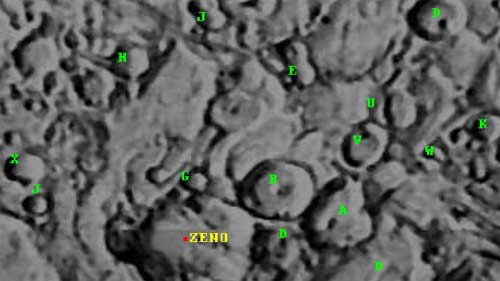|
|
Zeno of Elea (IPA:zɛnoʊ, ɛlɛɑː)(circa 490 BC? – circa 430 BC?) was a pre-Socratic Greek philosopher of southern Italy and a member of the Eleatic School founded by Parmenides. Called by Aristotle the inventor of the dialectic, he is best known for his paradoxes. In this capricious world nothing is more capricious than posthumous fame. One of the most notable victims of posterity's lack of judgement is the Eleatic Zeno. Having invented four arguments all immeasurably subtle and profound, the grossness of subsequent philosophers pronounced him to be a mere ingenious juggler, and his arguments to be one and all sophisms. After two thousand years of continual refutation, these sophisms were reinstated, and made the foundation of a mathematical renaissance... — Bertrand Russell, The Principles of Mathematics (1903)1 Life Little is known for certain about Zeno's life. Although written nearly a century after Zeno's death, the primary source of biographical information of Zeno is the dialogue of Plato called the Parmenides [1]. In the dialogue, Plato describes a visit to Athens by Zeno and Parmenides, at a time when Parmenides is "about 65", Zeno is "nearly 40" and Socrates is "a very young man" (Parmenides 127). Assuming an age for Socrates of around 20, and taking the date of Socrates birth as 470 BC, gives an approximate date of birth for Zeno of 490 BC. Plato says that Zeno was "tall and fair to look upon" and was "in the days of his youth … reported to have been beloved by Parmenides". (Parmenides 127) Other perhaps less reliable details of Zeno's life are given in Diogenes Laertius' Lives of Eminent Philosophers [2], where it is reported that he was the son of Teleutagoras, but the adopted son of Parmenides, was "skilled to argue both sides of any question, the universal critic", and further that he was arrested and perhaps killed at the hands of a tyrant of Elea. Works Although several ancient writers refer to the writings of Zeno, none survive intact. Plato says that Zeno's writings were "brought to Athens for the first time on the occasion of…" the visit of Zeno and Parmenides. Plato also has Zeno say that this work, "meant to protect the arguments of Parmenides" was written in Zeno's youth, stolen, and published without his consent. Plato has Socrates paraphrase the "first thesis of the first argument" of Zeno's work as follows: "…if being is many, it must be both like and unlike, and this is impossible, for neither can the like be unlike, nor the unlike like". According to Proclus in his Commentary on Plato's Parmenides, Zeno produced "…not less than forty arguments revealing contradictions..." (p. 29) Zeno's arguments are perhaps the first examples of a method of proof called Reductio ad absurdum also known as proof by contradiction. Zeno's paradoxes For more details on this topic, see Zeno's paradoxes. Zeno's paradoxes have puzzled, challenged, influenced, inspired, and amused philosophers, mathematicians, physicists and school children, for over two millennia. The most famous are the so-called "arguments against motion" described by Aristotle in his Physics [3]. The first three are given here, in the order, and with the names, as given by Aristotle, followed by a plausible modern interpretation: The Dichotomy: Motion is impossible since "that which is in locomotion must arrive at the half-way stage before it arrives at the goal." (Aristotle Physics VI:9, 239b10) That is, suppose an object moves from point A to point B. To get to point B the object must first reach the midpoint B1 between points A and B. However before this can be done the object must reach the midpoint B2 between points A and B1. Likewise before it can do this, it must reach the midpoint B3 between points A and B2, and so on. Therefore the motion can never begin. A-----B3-----B2-----------B1-------------------------B The Achilles: "In a race, the quickest runner can never overtake the slowest, since the pursuer must first reach the point whence the pursued started, so that the slower must always hold a lead." (Aristotle Physics VI:9, 239b15) That is, suppose Achilles is in a race with a tortoise. Achilles runs 10 times faster than the tortoise, but starts at point A, 100 yards behind the tortoise at point T1. To overtake the tortoise, Achilles must first reach the point T1. However when Achilles arrives at T1, the tortoise is now 10 yards in front at point T2. Again Achilles runs to T2. But, as before, once he has covered the 10 yards the tortoise is now a yard ahead of him, at point T3, and so on. Therefore Achilles can never overtake the tortoise. A----------------------------T1----------------T2---T3 The Arrow: "If everything when it occupies an equal space is at rest, and if that which is in locomotion is always occupying such a space at any moment, the flying arrow is therefore motionless." (Aristotle Physics VI:9, 239b5) That is, suppose an arrow is flying continuously forward during a certain time interval. Take any instant in that time interval. It is impossible that the arrow is moving during that instant because an instant has a duration of zero, and the arrow cannot be in two different places at the same time. Therefore, at every instant the arrow is motionless, hence the arrow is motionless throughout the entire interval. External links to online texts Diogenes Laertius' Lives of Eminent Philosophers References
Note 1 Russell p. 347 [edit]Further reading Early Greek Philosophy Jonathan Barnes. (Harmondsworth, 1987). "Zeno and the Mathematicians" G. E. L. Owen. Proceedings of the Aristotelian Society (1957-8). Paradoxes Mark Sainsbury. (Cambridge, 1988) Zeno's Paradoxes Wesley Salmon, ed. (Indianapolis, 1970). Zeno of Elea Gregory Vlastos in The Encyclopedia of Philosophy (Paul Edwards, ed.), (New York, 1967).
Lunar Crater Zeno Retrieved from "http://en.wikipedia.org/"
 |
|
|||||||||||||||

